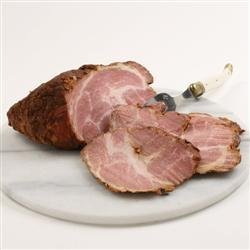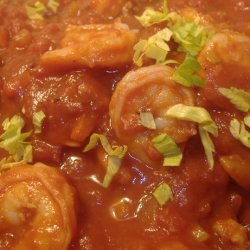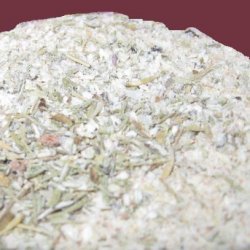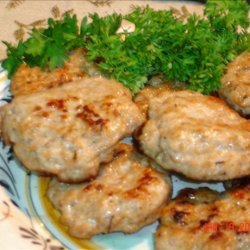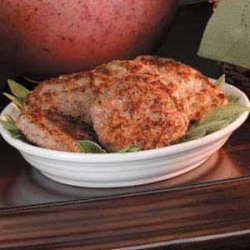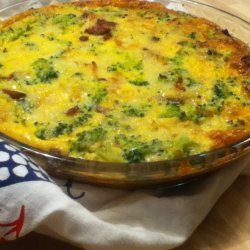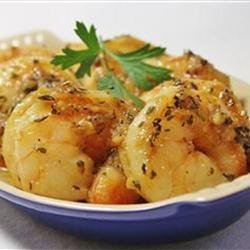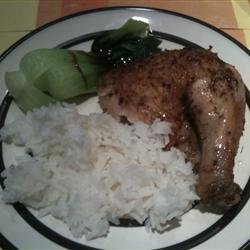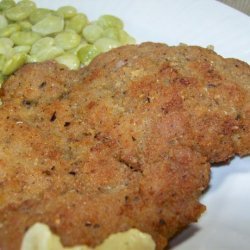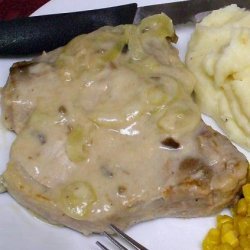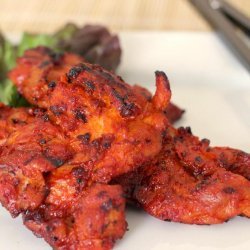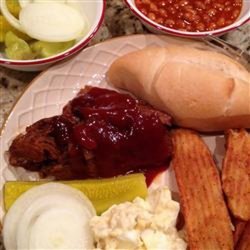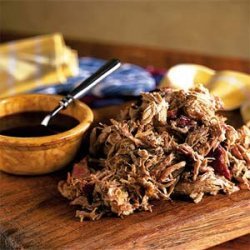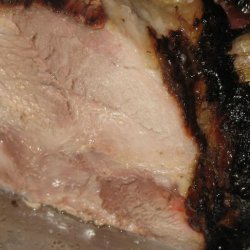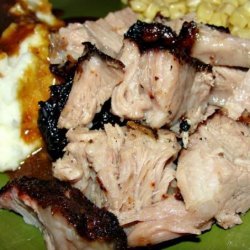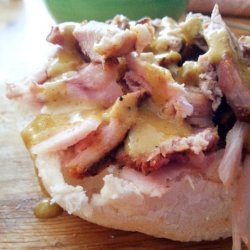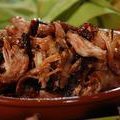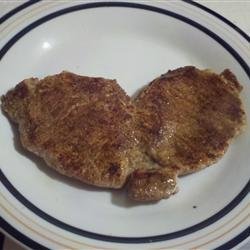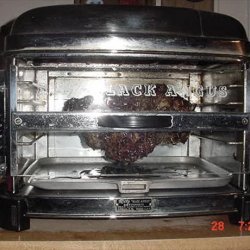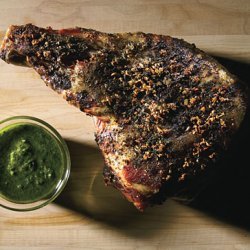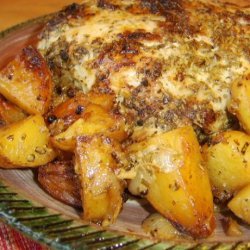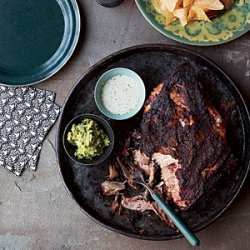Directions:
- IMPORTANT NOTE #1: This recipe makes a product that's quite salty, and meant to be used as a seasoning agent in small amounts (8 ounces) in jambalaya, beans and rice, or other Cajun-style savory foods. This tasso should not be considered a main dish the way a traditional ham would be. A 7-pound bone-in pork shoulder roast will yield about 4 pounds of usable tasso.
- IMPORTANT NOTE #2: Be sure to buy a bag of Morton brand Tender Quick home meat cure before making this recipe. Use 2 cups of the Morton cure and 8 cups of water to prepare the brine. Food,com does not recognize the Morton cure as an ingredient, so I couldn't list it in the Ingredients section. It's usually found in the spice aisle of larger supermarkets, in a dark blue paper sack, near the regular table salt.
- IMPORTANT NOTE #3: You also will need 7 to 9 chunks of throughly dried hickory wood, about 4 inches x 4 inches each. These are usually available wherever smokers are sold, like Home Depot where the Brinkmann smoker is sold. Soak the chunks in very hot water for about 20 minutes. You may need to put a weight on them to ensure they're completely submerged. Put the soaked chunks in a sealed plastic bag, so they stay moist until needed.
- RECIPE DIRECTIONS:.
- Follow the directions on the bag of Morton cure for making a wet brine, but use 2 cups cure and 8 cups water. Mix until cure is completely dissolved. Leave the skin on the pork shoulder. Submerge the meat in the brine. Weight it, if necessary, to keep it fully submerged. Cure, under refrigeration, for 24 hours.
- If you can't find the Morton cure, you can use 1 cup plain table sugar and 1 cup plain table salt to make the brine. The Morton cure usually is located in the spice aisle of larger supermarkets, near the regular salt.
- Remove the meat from the brine and dry thoroughly. Remove the tough outer skin, but leave the fat layer that's underneath the skin. Combine the spices, maple syrup, oil and water to make a wet rub that should have a spreadable consistency like thick heavy cream. Coat the meat evenly on all sides with the wet rub, just before putting it into the smoker. Use a brush or your hands to apply the rub. If you don't have maple syrup, substitute honey or dark corn syrup.
- Insert a heat-proof thermometer into the thickest part of the meat. Prepare the smoker according to the manufacturer's directions, being sure to include the pan of water. You can add aromatics to the water pan, if desired, for example: lemon zest (yellow part only), whole peppercorns (black, white or pink), bay leaves, dry sherry wine or dry marsala wine. If using wine, replace 1 to 2 cups of the water in the smoker's bowl with 1 to 2 cups wine. Use the zest of a least 2 lemons, 10 to 20 peppercorns and 4 ro 5 bay leaves and add to water in pan. This will give the meat an extra dimension of flavor as it smokes. Place the meat in the smoker, according to manufacturer's instructions.
- Add 3 large, well-soaked hickory chunks to the smoker, per manufacturer's directions. Wood should not touch the heating elements. Put the cover on the smoker and smoker and smoke for 6 to 6 1/2 hours or until meat reaches an internal temperature of about 165 degrees.
- A rough estimate is to smoke 45 to 60 minutes per pound of meat. Add 2 or 3 more well-soaked hickory chunks at 2 hour intervals, or as the wood in the smoker depletes. Figure on 2 addtions of 2 or 3 chunks over the entire cooking time.
- When the internal temperature of the meat reaches 165 degrees, remove it from smoker and tent with aluminum foil. It should rise another 5 degrees to the food-safe temperature of 170 degrees. Let the meat cool at room temperature for at least 1 1/2 hours. Remove the strings and refrigerate, uncovered, until completely cooled. Portion the meat only after it's thoroughly cooled, so any juices are retained.
Nutrition Facts
| Amount Per 1 Serving | |||
| Calories | 5061.92 Kcal (21193 kJ) | ||
| Calories from fat | 4737.91 Kcal | ||
| % Daily Value* | |||
| Total Fat | 526.43g | 810% | |
|---|---|---|---|
| Cholesterol | 571.41mg | 190% | |
| Sodium | 385.76mg | 16% | |
| Potassium | 2694.17mg | 57% | |
| Total Carbs | 5.96g | 2% | |
| Sugars | 3.19g | 13% | |
| Dietary Fiber | 0.94g | 4% | |
| Protein | 71.91g | 144% | |
| Vitamin C | 0.6mg | 1% | |
| Iron | 1.3mg | 7% | |
| Calcium | 184.9mg | 18% | |
| Amount Per 100 g | |||
| Calories | 393.93 Kcal (1649 kJ) | ||
| Calories from fat | 368.71 Kcal | ||
| % Daily Value* | |||
| Total Fat | 40.97g | 810% | |
|---|---|---|---|
| Cholesterol | 44.47mg | 190% | |
| Sodium | 30.02mg | 16% | |
| Potassium | 209.66mg | 57% | |
| Total Carbs | 0.46g | 2% | |
| Sugars | 0.25g | 13% | |
| Dietary Fiber | 0.07g | 4% | |
| Protein | 5.6g | 144% | |
| Iron | 0.1mg | 7% | |
| Calcium | 14.4mg | 18% | |
* Percent Daily Values are based on a 2000 calorie diet. Your daily values may be higher or lower depending on your calorie needs.
Find out how many calories should you eat.
Get Your Recipe of Health!
Follow RecipeOfHealth on Facebook!


